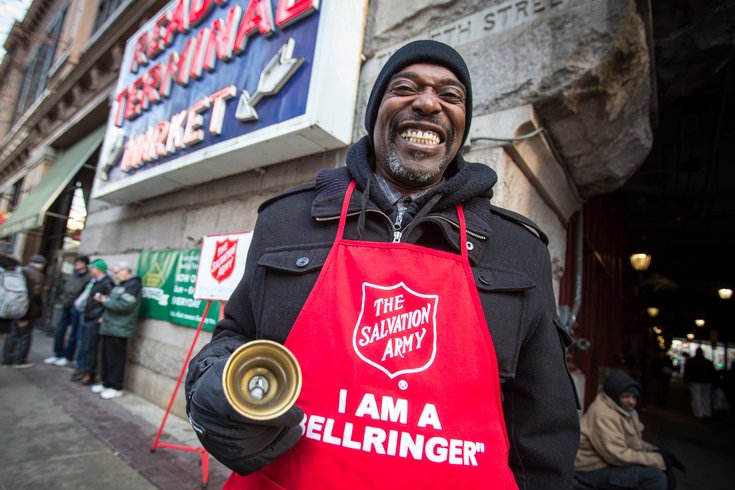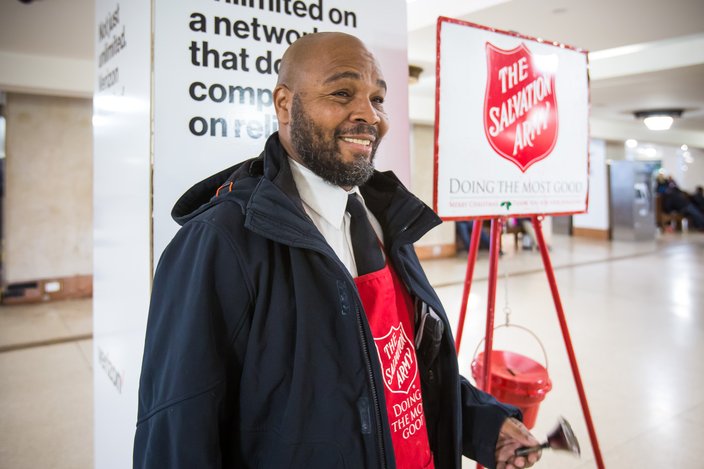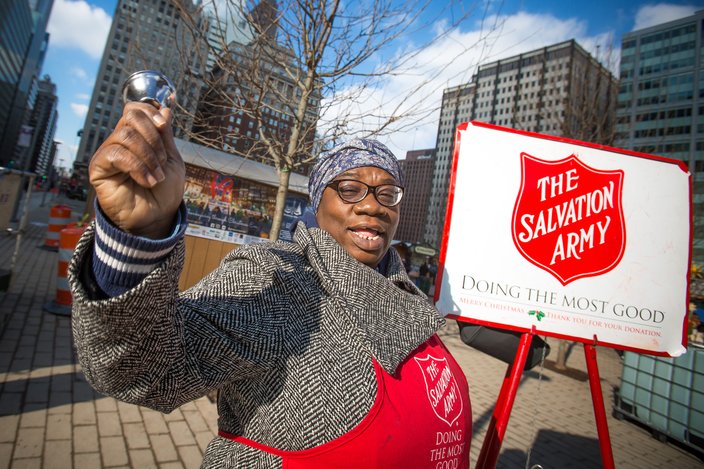
December 15, 2017
 Thom Carroll/PhillyVoice
Thom Carroll/PhillyVoice
Leon Braxton collects donations on the corner of 13th and Filbert Streets by Reading Terminal Market.
James Parker is certainly cordial.
Everyone who passes by his Salvation Army Red Kettle donation stand gets a polite "Hello," and the tired smile rarely leaves his face.
When a Regional Rail train pulls into the City Hall SEPTA concourse and commuters flock up the stairs toward Parker's post, however, it's the bell that works like a magnet. Passersby almost instinctively reach into their pockets or purses for handfuls of change or crumpled dollar bills to drop into the pot.
"Just smiling and saying hello to people, and ring my bell," says Parker. "The bell does the job. I don't really do nothing."
What's the secret to the Salvation Army raking in well more than $100 million each holiday season to fund its many charitable programs?
Is it the bright demeanor of those who collect donations on the sidewalk from Thanksgiving through Christmas Eve? How about the gimmicks, like the woman at Broad and Walnut who sings a customized, two-word tune ("Merry Christmas, Merry Christmas...")? Or just the kindness of strangers?
All of the above to a degree, probably. Mostly, though, it's that little bell.
James Parker collects donations in the concourse of Suburban Station, Monday, Dec. 11, 2017.
"I believe I'm working for God, this is how I feel. God blesses me and the Salvation Army. So, I donate my time." – James Parker, Salvation Army volunteer
Now, it's not just the bell. It's the entire setup – the bright red kettle, the Salvation Army sign sitting above it, the apron on collectors, who are either volunteers or work part-time.
"There is a trigger with the bell," says Dr. Thea Gallagher, a psychologist who directs the University of Pennsylvania's clinic on treating and studying anxiety. "You can't ignore it, you have to look."
Turn your attention to a bell ringer, and there’s a good chance you’re hit with a wave of nostalgia, flipping on a charitable switch.
“Generally, people feel on some level, a sense of joy and excitement that we project onto things all the time,” Gallagher says.
The Christian charitable organization’s Red Kettle program has been around for more than a century. The strength of its operation is built on the dedication of the Salvation Army's troops, but it churns along thanks to its unmistakable branding.
Susan Lockwood rings a bell underground near the Suburban Station concourse.
The "Army" in Salvation Army isn't trivial. The organization has a military structure, as its local churches are called “corps,” and its members rank anywhere between soldier and general. There's a deep sense of loyalty among the ranks.
"I believe I'm working for God, this is how I feel," says Parker, who's with the Army' Kroc Center in Philly's Nicetown neighborhood. "God blesses me and the Salvation Army. So, I donate my time."
Susan Lockwood, 78, has been coming out for the Red Kettle program for 29 years and has been at the same spot inside the City Hall subway concourse, a short march away from Parker, for the past 12 years. She's been experiencing some health problems, so this year will be her last.
Nevertheless, on Monday she had been out collecting donations since 6 a.m. and wouldn't be finished until 2 p.m., a shift made easier the past decade-plus by being assigned to an underground post.
"It's a drier kind of cold than when you're out in the elements. I did that for quite a few years," Lockwood says. "Once the sun goes down, forget it. They tell you to dress in layers, but the cold goes right through it."
On top of the cold, there's the occasional odd encounter with people on the street. Leon Baxter, parked outside Reading Terminal Market, recalls a woman putting a rock labeled "Navy sucks" on his kettle on the Saturday of the Army/Navy Game in Philly. Parker remembers a homeless man having pennies in his mouth, spitting them out into his hand and placing them in the kettle.
"That's gross," Parker says. "Money's dirty, why would you put it in your mouth?"
Carl McAphee of the Salvation Army collects donations outside of the Macy's Department store on Market Street.
Braving the sometimes bitter – and bizarre — winter helps pay for the Salvation Army's various services, including feeding and sheltering the homeless, addiction services, after-school programs and anti-human trafficking campaigns, according to Phil Pagliaro, marketing director for the Salvation Army of Greater Philadelphia.
"Christmas songs usually have bells in them, and they're usually only around during the holiday season. There's an association with those happy feelings. People have more positive, giving feelings (around the holidays) as well." – Thea Gallagher, Penn psychologist
Last year's Red Kettle drive provided 450,000 meals in Philadelphia and 56 million meals nationally, Pagliaro says. Nationwide, it raised $147 million in 2016. Pagliaro says he doesn't have specific dollar amounts for how much is raised locally, but noted this year's campaign was 50 percent below its goal as of Thursday.
Making up that difference will rely heavily on the Salvation Army's volunteers, Pagliaro says. Familiarity with the organization pays dividends, says McAphee, who tries to boost donations by belting, "Hey, Merry Christmas!" and allowing children to ring the bell.
"But most of them know what the Salvation Army does, most of the people that put money in there know that the Salvation Army does things for people," McAphee says.
Maintaining the look of a Salvation Army Red Kettle stand for all these years, Penn's Gallagher says, gives people a sense of comfort in donating.
"It doesn’t seem like they’ve really tried to change anything, which probably leads to trust," she says.
Tracey Boyer of the Salvation Army was stationed at the entrance to LOVE Park, Monday, Dec. 11, 2017.
That trust can lead to someone writing out a $500 check on the spot, like the one someone left in Tracey Boyer's kettle once. (Boyer, who is set up outside Christmas Village in LOVE Park for her fifth year collecting for the Red Kettle program, is a "beast" at drumming up donations, according to Parker.)
It also likely helps lead to a steady stream of smaller donations, Gallagher says, as throwing in some loose change doesn't feel skimpy but instead perfectly generous, with the clinking of the coins adding to the experience.
"It’s a little different when you’re going up and giving change," she says. "It's a physical thing you can go do, it’s a concrete thing. It makes you feel like you're making a difference."
It’s also something you may do multiple times without a second thought, and is probably easier than, say, remembering to donate online, Gallagher says (although you can do that for the Red Kettle program here, Pagliaro notes).
There is a bit of "social shame" that fuels donating in many situations, according to Gallagher, like when a grocery store clerk asks if you want to add a dollar to your bill for charity. "You don't want to be like a monster and say no," she jokes.
Again, though, much credit is owed to the bells. Plenty of street solicitors are friendly, but they’re not all backed by such an iconic symbol.
"Christmas songs usually have bells in them, and they're usually only around during the holiday season," Gallagher says. "There's an association with those happy feelings. People have more positive, giving feelings (around the holidays) as well."
The Red Kettle's presentation is such a big part of the program’s equation, one might wonder how much it actually matters if a volunteer is friendly or cheery; presented with this theory, Gallagher said it would be interesting to research whether a particularly friendly volunteer was any more effective than an apathetic one.
Just don't tell that to the troops on the ground.
"Courtesy and Christmas spirit, you put them together and what do you get?" asks Braxton, withholding the answer like the punchline to a joke. "You get a dollar!"
 Thom Carroll/PhillyVoice
Thom Carroll/PhillyVoice Thom Carroll/PhillyVoice
Thom Carroll/PhillyVoice Thom Carroll/PhillyVoice
Thom Carroll/PhillyVoice Thom Carroll/PhillyVoice
Thom Carroll/PhillyVoice